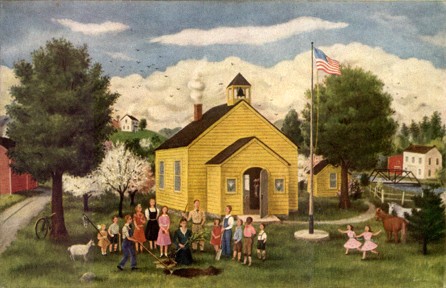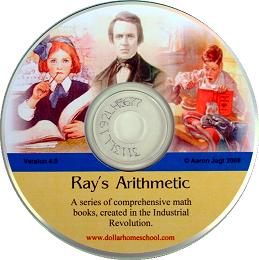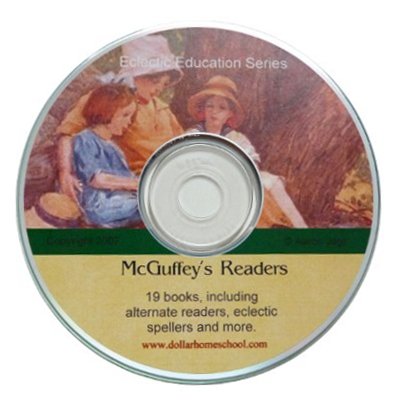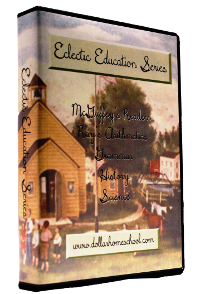McGuffey's Pictorial Eclectic Primer
|
Some interesting questions have recently come up.
First, I would like to explain the differences between the two sets of McGuffey's reprints that are now available.
The first is the "original" readers published by Mott Media. Can I say that I love these? They are printed with a sturdy binding, and the pages are thick for longevity and practical everyday use.
I believe it is their simplicity that make these books so endearing. The Primer begins with fairly crude pictures to accompany some basic words that are familiar to young readers. I was put off at first because things were not arranged according to phonics rules, but rather go from the simple to the complex. After using them for a while, I see the genius in McGuffey's thinking. My daughter absolutely loved the lessons, since they didn't seem "dumb" to her. We went very slowly, repeating each portion multiple times over several weeks. The results were quite remarkable--as I now have an encouraged, excited reader/writer on my hands!
The other books are amazing to read as well. My eldest daughter went from barely reading to fluency using the first reader. Subjects covered vary--but they are never trivial or boring. The Professor chose primarily to wisely deal with matters of the heart and morality--even including a story with an orphaned babe being taken in by an old gentleman bachelor! There are lessons with warnings dealing with laziness and the dangers of strong drink as well.
The vocabulary words presented in the first two readers are helpful. Again, there is no particular rhyme or reason to their inclusion, on the surface, but if they are used in oral reading and spelling, along with some basic copy work and dictation, their usefulness soon becomes apparent. It is almost magical to witness how these materials communicate with young fertile minds. I found that the hard work of learning was actually being accomplished by my children, and I only had to present the lessons and enjoy the process as I witnessed the wonderful transformations.
The advanced readers are very challenging reading. All of the readers are extremely Evangelical in nature; confession of sin, salvation through Jesus Christ, etc. are marvelously emphasized. This is continued in the 3rd and 4th books of the series, with apologetics for the Holy Bible also included. My daughter is working diligently through these and finds them replete with nourishment for the mind and soul!
The guide written by Ruth Beechick was very helpful to me, although I found that I had to adjust many of her thoughts and ideas to fit my children and our particular educational circumstances. If I had followed her suggestions verbatim, I would have become quite frustrated.
The originals are the only ones that can actually be attributed to McGuffey directly. The later versions, and there were many, were revised by different people, even his brother had a hand in some revisions.
Which brings us to the second set of McGuffey readers in publication today. These are commonly called the "revised" set, originally edited in 1879-1881 (there were revisions as late as the early 20th Century, which are hardly recognizable as McGuffey's, but these are not currently in print, that I am aware of). I own two sets of these; one antique (actually printed in 1920), the other a more recent, and less refined, facsimile which I purchased new.
My antique set is so beautiful--the leather bindings are deeply engraved and detailed; the colors of the covers are darker and brighter. The text is slightly raised and one can see the fine lines of the illustrations, as opposed to the muddied ones in the facsimile. Needless to say, the children do not have access to these at all, although I keep them in a slipcover on my desk and refer to them when writing up my lessons.
The 1879 revised edition that was recently printed is the set that my children use. I love these also. It is true that these are the least directly Evangelistic, but they still contain references to God and have many passages from the Bible. The lessons are moral and very engaging--a refreshing change from the meager offerings of these modern times.
The Primer not only uses simplicity, but also helps present the principles of phonics. For instance, the first lessons deal with short "a" words, the next lessons introduce short "o", and so on. This may be somewhat easier for the 21st Century mind to deal with.
The illustrations throughout are delightful. I enjoy viewing them myself--so I know that my children take pleasure in them.
There are not any modern guides to these available, and I personally felt quite lost until I discovered The Eclectic Manual of Methods--this book explains not only how the revised readers were meant to be used, but the arithmetics, grammars, etc. You can download this from the link above, and it can even be printed up and comb-bound. The Ray's and McGuffey's helps I sell on my blog contain a few suggestions that I fashioned after the ideas found in this manual.
Excerpt of a McGuffey Illustration
|
Since I am working on the plans for my own young learners, I am currently compiling a general guide to using the McGuffey's series together in an eBook format. I have a few images and some helps in place--but I will include some scripture passage suggestions for the lessons--I hope you will pray for me so that I will be able to find the time to put these resources together for you all! I also have another blog that I am developing which I hope to gradually fill with anything and everything we find interesting that was published during or about the "McGuffey" era of our history, both, The Guide to McGuffey and the blog will be about education and life--McGuffey's World.
I am not sure which set of readers is the best--they both have their merits. I am glad I have both! As of this writing, one could secure the original set, with speller and the Beechick guide, for between $70 - $109 (per set), before taxes and shipping.
The 1879 revised set can be purchased for about $69.
Dollar Homeschool has done a great job compiling all of the McGuffey's Eclectic Series and putting them on CD. The cost, compared to purchasing the actual books, many of which can no longer be obtained or found, is economical (the readers, with speller and extra books, $39). But if one wants to print and bind their own books from the CD, the price becomes the same or much more.
I often find myself lost in these little books—I am so glad I get to do the lessons, too!
I would like to leave you with a quote spoken originally by Dr. David Swing of Chicago and published originally in the book, A History of the McGuffey Readers by Henry Hobart Vail.
Much as you may have studied the languages or the sciences, that which most affected you was the moral lessons in the series of McGuffey. And yet the reading class was filed out only once a day to read for a few moments, and then we were all sent to our seats to spend two hours in learning how to bound New Hampshire or Connecticut, or how long it would take a greyhound to overtake a fox or a hare if the spring of each was so and so, and the poor fugitive had such and such a start. That was perhaps well, but we have forgotten how to bound Connecticut, and how to solve the equation of the field and thicket; but up out of the far-off years come all the blessed lessons in virtue and righteousness which those reading books taught; and when we now remember, how even these moral memories have faded, I cannot but wish the teachers had made us bound the States less, and solve fewer puzzles in 'position' and the 'cube root' and made us commit to memory the whole series of the McGuffey Eclectic Readers. The memory that comes from these far-away pages is full of the best wisdom of time or the timeless land. In these books we were indeed led by a schoolmaster, from beautiful maxims for children up to the best thoughts of a long line of sages, and poets, and naturalists. There we all first learned the awful weakness of the duel that took away a Hamilton; there we saw the grandeur of the Blind Preacher of William Wirt; there we saw the emptiness of the ambition of Alexander, and there we heard even the infidel say, "Socrates died like a philosopher, but Jesus Christ like a God."
































![[th_main-7-1.jpg]](https://blogger.googleusercontent.com/img/b/R29vZ2xl/AVvXsEiwoAG_w7NXFmqGUpURo_2aO-BqxZV3DXDIU0x40UaNVU0SUX946JQ3fideNz4Ldn-9a4M_WTYO4MsEc5GH0qT1VZoHGrcdZjVMAEr3ibN3HFeGoNPeAE1aczhPUu6xf-4DxTEqxCGSiAE/s220/th_main-7-1.jpg)























